Jordan’s
traditional arts are highly influenced by Islamic art and other traditions from
the region. Two of the most significant arts found in Jordan are ceramic arts
and mosaic arts. Many of these pieces include Islamic motifs and themes as well
as Islamic calligraphy. If you’ve ever seen Islamic calligraphy, it’s an art in
and of itself. Some can be quite elaborate. Mosaic art has been discovered in
many of the archaeological sites throughout the country and is a skill that is
still being encouraged today. In fact the government started a mosaic school in
order to preserve the mosaics that are found in these various historical sites.
It’s set up in the city of Madaba, which is known for its large mosaic map of
the Holy Land.
Another craft known
in Jordan is embroidery, especially that from the Palestinian women. They are
known for their textile needlework and typically use a variety of colors to
create patterns based on geometric shapes. It doesn’t stop there: Jordanians
are also known for their rug and carpet making as well as basket weaving. Most
of these items are designed for use in the home. Other small handicrafts such
as decorative bottles and jewelry are also commonly practiced.
Today, Jordanians
also study painting and sculpture and other contemporary arts. Amman is the
artistic center of the country, although other larger cities also have their
own arts support organizations. Amman has many art museums and smaller art
galleries spread throughout the city. These galleries not only showcase many of
Jordan’s finest artists but also the works of artists from the entire region.
Many Iraqi artists have fled to Jordan to escape the terrible conditions in
their country, and there are some galleries designed just for Iraqi art.
 |
| by Fadi Daoud |
Prior to the 20th
century, there really aren’t too many works of literature to note. Most of the
early literature was in the form of religious texts, and today the vast majority of literature produced is written in Arabic. One of the first Jordanian
poets to really become popular was Mustafa Wahbi al-Tal. Many of his poems used
humor to discuss life in Jordan as well serious subjects like anti-colonialism
and nationalism.
Only in the latter
part of the 20th century did Jordanian writers really take the
stage. Many of the most popular authors often tout Mounis al-Razzaz as one of
the instrumental figures in bringing contemporary Jordanian literature to the
limelight. One of the main themes that run through his works includes the
transition between small, traditional towns and the larger, more modern cities.
Rifka Doudeen is a
female author who has risen to popularity with her collection of short stories
and a novel. Other writers such as Ramadan al-Rawashdeh, Mefleh al-Adwan, Basma
Nsour, Abdullah Mansour, Abdel Raouf Shamoun, Hashim Ghareybeh, Jamal Naji, and
Raga Abu Gazaleh have won many awards and prizes for their works, which are
enjoyed throughout much of the Arab world.
There are a few
Palestinian authors who have risen to fame as well. There are several authors,
like Taher al-Edwan as well as many Palestinian/Jordanian authors who are
living abroad, who have written first hand on the Israeli-Palestinian conflict
and books that take place during events in this history. Many of these books
have also won national and international awards.
 |
| from Indiana Jones and the Last Crusade |
During the past
decade, Jordan has made significant pushes toward encouraging the film
industry. Several big-name films have been filmed in Jordan (Indiana Jones and the Last Crusade, Lawrence
of Arabia, The Hurt Locker, Transformers: Revenge of the Fallen, and
others), and many more are on the schedule. They do make their own films, and
many filmmaking companies across the region choose to film here for many
reasons. The popularity of writing films taking place in Iraq has risen, but
due to the instability of the security in that country, it’s not always safe to
actually film there. Thankfully, the terrain in Jordan is very similar to Iraq,
and there are many Iraqi refugees already in Jordan.
Up next: music and
dance





There is something great on Islamic art. Observing them in the museum, specially the old art mosaic, it is hard to imagine how creative they are from the old times. When I see Pics of Horses from the old painting, horses is one of the favorite subject they used.
ReplyDelete